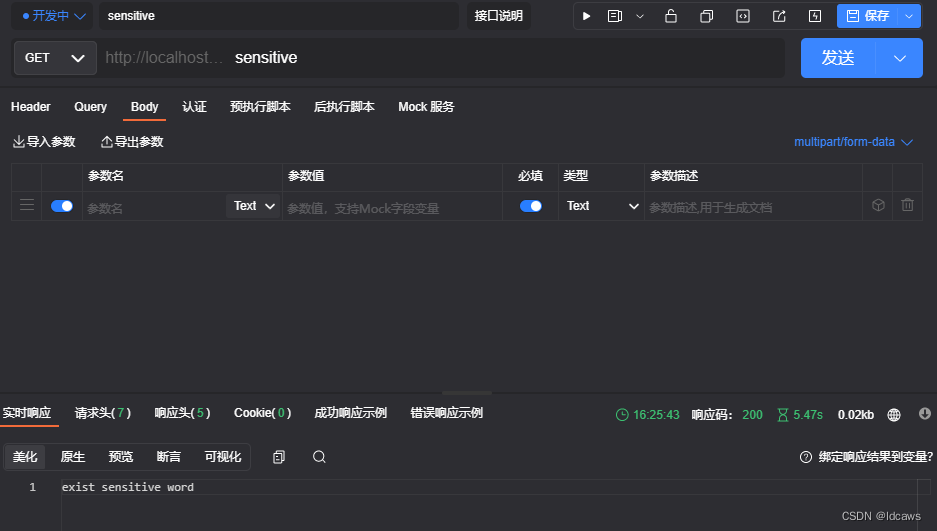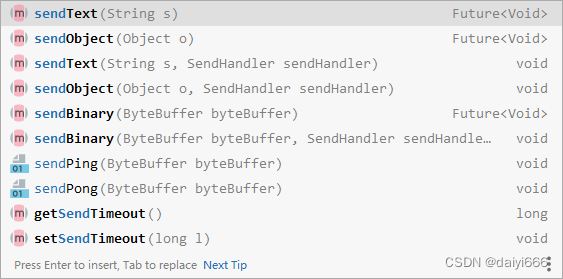springboot+redis实现简单的热搜功能
时间:2022-12-10使用springboot集成redis实现一个简单的热搜功能。
- 搜索栏展示当前登录的个人用户的搜索历史记录;
- 删除个人用户的搜索历史记录;
- 插入个人用户的搜索历史记录;
- 用户在搜索栏输入某字符,则将该字符记录下来以zset格式存储在redis中,记录该字符被搜索的个数;
- 当用户再次查询了已在redis存储了的字符时,则直接累加个数;
- 搜索相关最热的前十条数据;
实例
@Transactional
@Service("redisService")
public class RedisService {
@Resource
private StringRedisTemplate redisSearchTemplate;
/**
* 新增一条该userId用户在搜索栏的历史记录,searchKey代表输入的关键词
*
* @param userId
* @param searchKey
* @return
*/
public int addSearchHistoryByUserId(String userId, String searchKey) {
String searchHistoryKey = RedisKeyUtil.getSearchHistoryKey(userId);
boolean flag = redisSearchTemplate.hasKey(searchHistoryKey);
if (flag) {
Object hk = redisSearchTemplate.opsForHash().get(searchHistoryKey, searchKey);
if (hk != null) {
return 1;
} else {
redisSearchTemplate.opsForHash().put(searchHistoryKey, searchKey, "1");
}
} else {
redisSearchTemplate.opsForHash().put(searchHistoryKey, searchKey, "1");
}
return 1;
}
/**
* 删除个人历史数据
*
* @param userId
* @param searchKey
* @return
*/
public long delSearchHistoryByUserId(String userId, String searchKey) {
String searchHistoryKey = RedisKeyUtil.getSearchHistoryKey(userId);
return redisSearchTemplate.opsForHash().delete(searchHistoryKey, searchKey);
}
/**
* 获取个人历史数据列表
*
* @param userId
* @return
*/
public List<String> getSearchHistoryByUserId(String userId) {
List<String> history = new ArrayList<>();
String searchHistoryKey = RedisKeyUtil.getSearchHistoryKey(userId);
boolean flag = redisSearchTemplate.hasKey(searchHistoryKey);
if (flag) {
Cursor<Map.Entry<Object, Object>> cursor = redisSearchTemplate.opsForHash().scan(searchHistoryKey, ScanOptions.NONE);
while (cursor.hasNext()) {
Map.Entry<Object, Object> map = cursor.next();
String key = map.getKey().toString();
history.add(key);
}
return history;
}
return null;
}
/**
* 新增一条热词搜索记录,将用户输入的热词存储下来
*
* @param searchKey
* @return
*/
public int addHot(String searchKey) {
Long now = System.currentTimeMillis();
ZSetOperations zSetOperations = redisSearchTemplate.opsForZSet();
ValueOperations<String, String> valueOperations = redisSearchTemplate.opsForValue();
List<String> title = new ArrayList<>();
title.add(searchKey);
for (int i = 0, length = title.size(); i < length; i++) {
String tle = title.get(i);
try {
if (zSetOperations.score("title", tle) <= 0) {
zSetOperations.add("title", tle, 0);
valueOperations.set(tle, String.valueOf(now));
}
} catch (Exception e) {
zSetOperations.add("title", tle, 0);
valueOperations.set(tle, String.valueOf(now));
}
}
return 1;
}
/**
* 根据searchKey搜索其相关最热的前十名 (如果searchKey为null空,则返回redis存储的前十最热词条)
*
* @param searchKey
* @return
*/
public List<String> getHotList(String searchKey) {
String key = searchKey;
Long now = System.currentTimeMillis();
List<String> result = new ArrayList<>();
ZSetOperations zSetOperations = redisSearchTemplate.opsForZSet();
ValueOperations<String, String> valueOperations = redisSearchTemplate.opsForValue();
Set<String> value = zSetOperations.reverseRangeByScore("title", 0, Double.MAX_VALUE);
//key不为空的时候 推荐相关的最热前十名
if (StringUtils.isNotEmpty(searchKey)) {
for (String val : value) {
if (StringUtils.containsIgnoreCase(val, key)) {
//只返回最热的前十名
if (result.size() > 9) {
break;
}
Long time = Long.valueOf(valueOperations.get(val));
if ((now - time) < 2592000000L) {
//返回最近一个月的数据
result.add(val);
} else {
//时间超过一个月没搜索就把这个词热度归0
zSetOperations.add("title", val, 0);
}
}
}
} else {
for (String val : value) {
if (result.size() > 9) {
//只返回最热的前十名
break;
}
Long time = Long.valueOf(valueOperations.get(val));
if ((now - time) < 2592000000L) {
//返回最近一个月的数据
result.add(val);
} else {
//时间超过一个月没搜索就把这个词热度归0
zSetOperations.add("title", val, 0);
}
}
}
return result;
}
/**
* 每次点击给相关词searchKey热度 +1
*
* @param searchKey
* @return
*/
public int incrementHot(String searchKey) {
String key = searchKey;
Long now = System.currentTimeMillis();
ZSetOperations zSetOperations = redisSearchTemplate.opsForZSet();
ValueOperations<String, String> valueOperations = redisSearchTemplate.opsForValue();
zSetOperations.incrementScore("title", key, 1);
valueOperations.getAndSet(key, String.valueOf(now));
return 1;
}
}在向redis添加搜索词汇时需要过滤不雅文字,合法时再去存储到redis中,下面是过滤不雅文字的过滤器。
public class SensitiveFilter {
/**
* 敏感词库
*/
private Map sensitiveWordMap = null;
/**
* 最小匹配规则
*/
public static int minMatchType = 1;
/**
* 最大匹配规则
*/
public static int maxMatchType = 2;
/**
* 单例
*/
private static SensitiveFilter instance = null;
/**
* 构造函数,初始化敏感词库
*
* @throws IOException
*/
private SensitiveFilter() throws IOException {
sensitiveWordMap = new SensitiveWordInit().initKeyWord();
}
/**
* 获取单例
*
* @return
* @throws IOException
*/
public static SensitiveFilter getInstance() throws IOException {
if (null == instance) {
instance = new SensitiveFilter();
}
return instance;
}
/**
* 获取文字中的敏感词
*
* @param txt
* @param matchType
* @return
*/
public Set<String> getSensitiveWord(String txt, int matchType) {
Set<String> sensitiveWordList = new HashSet<>();
for (int i = 0; i < txt.length(); i++) {
// 判断是否包含敏感字符
int length = checkSensitiveWord(txt, i, matchType);
// 存在,加入list中
if (length > 0) {
sensitiveWordList.add(txt.substring(i, i + length));
// 减1的原因,是因为for会自增
i = i + length - 1;
}
}
return sensitiveWordList;
}
/**
* 替换敏感字字符
*
* @param txt
* @param matchType
* @param replaceChar
* @return
*/
public String replaceSensitiveWord(String txt, int matchType, String replaceChar) {
String resultTxt = txt;
// 获取所有的敏感词
Set<String> set = getSensitiveWord(txt, matchType);
Iterator<String> iterator = set.iterator();
String word = null;
String replaceString = null;
while (iterator.hasNext()) {
word = iterator.next();
replaceString = getReplaceChars(replaceChar, word.length());
resultTxt = resultTxt.replaceAll(word, replaceString);
}
return resultTxt;
}
/**
* 获取替换字符串
*
* @param replaceChar
* @param length
* @return
*/
private String getReplaceChars(String replaceChar, int length) {
String resultReplace = replaceChar;
for (int i = 1; i < length; i++) {
resultReplace += replaceChar;
}
return resultReplace;
}
/**
* 检查文字中是否包含敏感字符,检查规则如下:<br>
* 如果存在,则返回敏感词字符的长度,不存在返回0
*
* @param txt
* @param beginIndex
* @param matchType
* @return
*/
public int checkSensitiveWord(String txt, int beginIndex, int matchType) {
// 敏感词结束标识位:用于敏感词只有1位的情况
boolean flag = false;
// 匹配标识数默认为0
int matchFlag = 0;
Map nowMap = sensitiveWordMap;
for (int i = beginIndex; i < txt.length(); i++) {
char word = txt.charAt(i);
// 获取指定key
nowMap = (Map) nowMap.get(word);
// 存在,则判断是否为最后一个
if (nowMap != null) {
// 找到相应key,匹配标识+1
matchFlag++;
// 如果为最后一个匹配规则,结束循环,返回匹配标识数
if ("1".equals(nowMap.get("isEnd"))) {
// 结束标志位为true
flag = true;
// 最小规则,直接返回,最大规则还需继续查找
if (SensitiveFilter.minMatchType == matchType) {
break;
}
}
}
// 不存在,直接返回
else {
break;
}
}
if (SensitiveFilter.maxMatchType == matchType) {
//长度必须大于等于1,为词
if (matchFlag < 2 || !flag) {
matchFlag = 0;
}
}
if (SensitiveFilter.minMatchType == matchType) {
//长度必须大于等于1,为词
if (matchFlag < 2 && !flag) {
matchFlag = 0;
}
}
return matchFlag;
}
}@Configuration
@SuppressWarnings({"rawtypes", "unchecked"})
public class SensitiveWordInit {
/**
* 字符编码
*/
private String ENCODING = "UTF-8";
/**
* 初始化敏感字库
*
* @return
* @throws IOException
*/
public Map initKeyWord() throws IOException {
// 读取敏感词库,存入Set中
Set<String> wordSet = readSensitiveWordFile();
// 将敏感词库加入到HashMap中
return addSensitiveWordToHashMap(wordSet);
}
/**
* 读取敏感词库 ,存入HashMap中
*
* @return
* @throws IOException
*/
private Set<String> readSensitiveWordFile() throws IOException {
Set<String> wordSet = null;
ClassPathResource classPathResource = new ClassPathResource("static/sensitiveWord.txt");
InputStream inputStream = classPathResource.getInputStream();
// 敏感词库
try {
// 读取文件输入流
InputStreamReader read = new InputStreamReader(inputStream, ENCODING);
// 文件是否是文件 和 是否存在
wordSet = new HashSet<>();
// BufferedReader是包装类,先把字符读到缓存里,到缓存满了,再读入内存,提高了读的效率。
BufferedReader br = new BufferedReader(read);
String txt = null;
// 读取文件,将文件内容放入到set中
while ((txt = br.readLine()) != null) {
wordSet.add(txt);
}
br.close();
// 关闭文件流
read.close();
} catch (Exception e) {
e.printStackTrace();
}
return wordSet;
}
/**
* 将HashSet中的敏感词,存入HashMap中
*
* @param wordSet
* @return
*/
private Map addSensitiveWordToHashMap(Set<String> wordSet) {
// 初始化敏感词容器,减少扩容操作
Map wordMap = new HashMap(wordSet.size());
for (String word : wordSet) {
Map nowMap = wordMap;
for (int i = 0; i < word.length(); i++) {
// 转换成char型
char keyChar = word.charAt(i);
// 获取
Object tempMap = nowMap.get(keyChar);
// 如果存在该key,直接赋值
if (tempMap != null) {
nowMap = (Map) tempMap;
}
// 不存在则,则构建一个map,同时将isEnd设置为0,因为他不是最后一个
else {
// 设置标志位
Map<String, String> newMap = new HashMap<>();
newMap.put("isEnd", "0");
// 添加到集合
nowMap.put(keyChar, newMap);
nowMap = newMap;
}
// 最后一个
if (i == word.length() - 1) {
nowMap.put("isEnd", "1");
}
}
}
return wordMap;
}
}其中用到的sensitiveWord.txt文件在resources目录下的static目录中,这个文件是不雅文字大全,需要与时俱进,不断进步的。
测试
@GetMapping("/add")
public Object add() {
int num = redisService.addSearchHistoryByUserId("001", "hello");
return num;
}
@GetMapping("/delete")
public Object delete() {
long num = redisService.delSearchHistoryByUserId("001", "hello");
return num;
}
@GetMapping("/get")
public Object get() {
List<String> history = redisService.getSearchHistoryByUserId("001");
return history;
}
@GetMapping("/incrementHot")
public Object incrementHot() {
int num = redisService.addHot("母亲节礼物");
return num;
}
@GetMapping("/getHotList")
public Object getHotList() {
List<String> hotList = redisService.getHotList("母亲节礼物");
return hotList;
}
@GetMapping("/incrementScore")
public Object incrementScore() {
int num = redisService.incrementHot("母亲节礼物");
return num;
}
@GetMapping("/sensitive")
public Object sensitive() throws IOException {
//非法敏感词汇判断
SensitiveFilter filter = SensitiveFilter.getInstance();
int n = filter.checkSensitiveWord("hello", 0, 1);
if (n > 0) {
//存在非法字符
System.out.printf("这个人输入了非法字符--> %s,不知道他到底要查什么~ userid--> %s","hello","001");
return "exist sensitive word";
}
return "ok";
}
到此这篇关于springboot+redis实现热搜的文章就介绍到这了,更多相关springboot redis热搜内容请搜索html5模板网以前的文章希望大家以后多多支持html5模板网!
相关文章
 SpringBoot+WebSocket实现即时通讯的方法详解这篇文章主要为大家详细介绍了如何利用SpringBoot+WebSocket实现即时通讯功能,文中示例代码讲解详细,对我们学习或工
SpringBoot+WebSocket实现即时通讯的方法详解这篇文章主要为大家详细介绍了如何利用SpringBoot+WebSocket实现即时通讯功能,文中示例代码讲解详细,对我们学习或工 SpringBoot 二维码生成base64并上传OSS的实现示例本文主要介绍了SpringBoot二维码生成base64并上传OSS的实现示例,文中通过示例代码介绍的非常详细,对大家的学习或者
SpringBoot 二维码生成base64并上传OSS的实现示例本文主要介绍了SpringBoot二维码生成base64并上传OSS的实现示例,文中通过示例代码介绍的非常详细,对大家的学习或者 在SpringBoot中使用HATEOAS的方法这篇文章主要介绍了在SpringBoot中使用HATEOAS的方法,HATEOAS是实现REST规范的一种原则,通过遵循HATEOAS规范,可以解决我
在SpringBoot中使用HATEOAS的方法这篇文章主要介绍了在SpringBoot中使用HATEOAS的方法,HATEOAS是实现REST规范的一种原则,通过遵循HATEOAS规范,可以解决我 springboot+redis实现微博热搜排行榜的示例代码本文主要介绍了springboot+redis实现微博热搜排行榜的示例代码,文中通过示例代码介绍的非常详细,对大家的学习或者
springboot+redis实现微博热搜排行榜的示例代码本文主要介绍了springboot+redis实现微博热搜排行榜的示例代码,文中通过示例代码介绍的非常详细,对大家的学习或者 SpringBoot+Redis哨兵模式的实现本文主要介绍了SpringBoot+Redis哨兵模式的实现,文中通过示例代码介绍的非常详细,对大家的学习或者工作具有一定的
SpringBoot+Redis哨兵模式的实现本文主要介绍了SpringBoot+Redis哨兵模式的实现,文中通过示例代码介绍的非常详细,对大家的学习或者工作具有一定的 SpringBoot中@Import注解的使用方式这篇文章主要介绍了SpringBoot中@Import注解的使用方式,文章围绕主题展开详细的内容介绍,具有一定的参考价值,需要
SpringBoot中@Import注解的使用方式这篇文章主要介绍了SpringBoot中@Import注解的使用方式,文章围绕主题展开详细的内容介绍,具有一定的参考价值,需要
 Java与C++分别用递归实现汉诺塔详解汉诺塔问题是一个经典的问题。汉诺塔(HanoiTower),又称河内塔,源于印度一个古老传说。本文将用Java与C++分别实现,感兴
Java与C++分别用递归实现汉诺塔详解汉诺塔问题是一个经典的问题。汉诺塔(HanoiTower),又称河内塔,源于印度一个古老传说。本文将用Java与C++分别实现,感兴